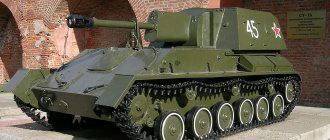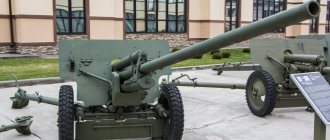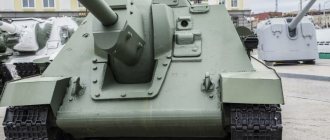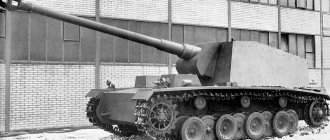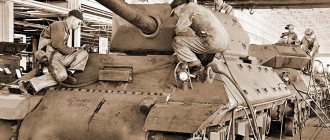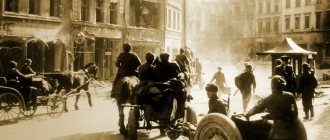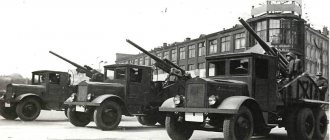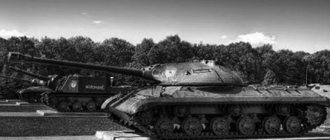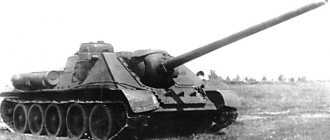Stories about weapons. "Sprut-B" as the end and the beginning at the same time
Indeed, “Sprut-B” is a very unique phenomenon in the history of our artillery.
Currently, the 2A45M Sprut-B is considered the most powerful anti-tank gun in the world. Meanwhile, this is a story with a kind of continuation, and, I would say, the continuation turned out to be very successful. And it all started far from rosy.
It all started back in 1968 as a continuation of the development of the idea of self-propelled guns. A task was issued to develop an anti-tank gun with ballistics and ammunition of the 125-mm smoothbore tank gun D-81 (2A46).
Work on the task was started by the already mentioned OKB-9 of F. F. Petrov. The chief designer of the project was V. A. Golubev.
At the same time, two options were designed: the towed D-13 cannon and the self-propelled SD-13.
The 2A45 SD-13 (“Sprut-A”) was produced, but the 2A45M “Sprut-B” gun also went into production.
The Sprut-B cannon was obtained by superimposing the D-81 tank gun on the carriage of a towed 122-mm D-30 howitzer plus propulsion units.
The gun barrel is about 51 caliber long and consists of a pipe with a muzzle brake, secured by a casing in the chamber part, and a breech. The barrel is not threaded, which ensured that a higher pressure of powder gases was obtained in the barrel bore and imparted to the projectile a very high initial velocity, increasing its armor penetration. For example, the Sprut-B sub-caliber armor-piercing projectile has an initial speed of 1700 m/s compared to 1040 m/s for the D-48 anti-tank 85-mm rifled gun.
Anti-recoil devices (hydraulic recoil brake and pneumatic knurling) are located above the barrel in the cradle box.
The gun is equipped with a bolt with a vertically located wedge and a mechanical (copier) semi-automatic mechanism. The safety mechanism located at the bottom of the bolt prevents firing if it is not completely closed. Before the first shot, the shutter opens manually, and later, due to the recoil energy, it opens automatically. At the same time, the firing pin is cocked and the spent cartridge is ejected. In order to prevent the appearance of a backfire after a shot, there is a special mechanism for purging the barrel bore.
"Sprut-B" has several sighting devices. In the daytime, when firing direct fire, the OP4M-48A optical sight is used, and at night, the 1PN53-1 night sight is used. The gun has a 2TsZZ mechanical sight, which is used in conjunction with the PG-1M panorama for firing from closed positions.
The wheels of the chassis are mounted on the upper machine of the carriage, which hang above the ground when the gun is moved into the firing position.
The transfer of the gun from the traveling position to the combat position is carried out using a mechanized system, which includes a hydraulic motor, a hydraulic jack and hydraulic cylinders.
The jack ensures that the carriage is raised to the height required for bringing the frames together and apart, and for lowering it to the ground. Hydraulic cylinders lift the gun to maximum ground clearance, as well as raise and lower the wheels. The hydraulic motor can be powered by a hand pump, but the main source of energy for it is the auxiliary power unit, located on the frame of the upper machine in front of the shield cover (to the right of the barrel).
The auxiliary installation is made on the basis of the MeMZ-967A engine and is used both to mechanize the processes of transferring the gun from the firing position to the traveling position and back, and to ensure the self-propulsion of the gun on the battlefield.
Yes, dear ones, “tse vona”. The legendary "thirty" of the Melitopol plant, the heart of thousands of "Zaporozhets" and "Volyn". Unpretentious, repairable with a minimum set of both tools and technical knowledge, but capable of producing 30 (okay, 27) “horses” in the field.
The controls and driver's seat are located on the frame of the upper machine to the left of the barrel. When using an auxiliary power unit, the maximum speed of the gun on dry dirt roads reaches 10 km/h. The fuel range is 50 km.
Yes, in terms of comfort it’s not even LuAZ. I don’t know how to drive, how to sit... No, it’s not an SD-44 anymore, but still not very good.When making a march, it is preferable, of course, to tow the gun with any available tractor, Ural, KamAZ, MT-LB.
The Sprut-B cannon fires using separate-case-loading shots from the D-81 tank gun. HEAT, anti-tank, sub-caliber and high-explosive fragmentation shells are used.
The gun has a fairly high rate of fire: 6-8 rounds per minute. The permissible mode of continuous fire for one hour is 100 shots.
Since the gun barrel does not have rifling, when installing the 9S53 guidance complex, it becomes possible to fire ZUBK14 rounds (the 9M119 laser-beam-guided anti-tank missile).
A total of 24 examples of the gun were produced. There is no data on the combat use of Sprut-B.
This, in principle, is where the story of self-propelled guns ends.
Despite all the seemingly advantageous mobility, self-propelled guns did not have the proper range and protection for the crew when moving from one firing position to another in battle conditions. And they still required tractors to move over longer distances than 5-10 km.
Everyone understood that the result was a very successful Sprut-B cannon. It, or rather its characteristics, are still relevant today, despite its rather long service life. On the other hand, what more could you want if it still penetrates the armor of “potential” tanks?
It is clear that there must be a next step. And it was done when an armored frame was erected around the same gun, a more powerful engine and a tracked chassis were given.
Everyone has already understood that we are talking about Sprut-SD. Everything is the same, but a self-propelled and airborne weapon. This, however, is another story, but, nevertheless, it is the best ending of all that self-propelled guns could have.
Sources: Shirokorad A. B. Encyclopedia of Russian Artillery. Shirokorad A. B. Domestic anti-tank artillery.
Links[edit]
- Hull, A. V., Markov, D. R., Zaloga, S. J. (1999). Soviet/Russian methods of designing armored vehicles and artillery from 1945 to the present
. Darlington Productions. ISBN 1-892848-01-5. - Military parade
- Enemy forces
- 2A45M on the manufacturer's website
- Jane's Armor and Artillery 2002-2003
- "SPRUT". Retrieved November 13, 2014. CS1 maint: discouraged parameter (link)
- "Octopus". Retrieved November 13, 2014. CS1 maint: discouraged parameter (link)
Key Features
According to experts, the new self-propelled gun, in appearance and firepower, is comparable to a tank, is characterized by the maneuverability of the airborne BMD-3 and has no analogues abroad. In addition, the Sprut-SD is equipped with a unique hydropneumatic chassis, which allows the combat vehicle to move smoothly and quickly in off-road conditions at speeds of up to 70 km per hour, which significantly improves the conditions for firing while on the move.
In addition, Sprut-SD is capable of overcoming water obstacles at afloat speeds of up to 10 km per hour. This was confirmed by tests in the North Sea, when during a storm of up to 3 points the BM confidently fired at the designated targets. The vehicle can parachute from cargo ships onto the water surface and independently return to the ship. The noted and other qualities, together with the circular rotation of the turret and the stabilization of weapons in two planes, allow the Sprut-SD to be used as a light amphibious tank.
Main tactical and technical characteristics of the 2S25 Sprut-SD self-propelled anti-tank gun
| Combat weight, t | 18 |
| Main dimensions, m: | |
| length (with gun) | 7,07 (9,771) |
| width | 3,152 |
| height (with wind sensor) | 2,72 (2,98) |
| Maximum speed, km/h: | |
| along the highway | up to 70 |
| on the ground | up to 49 |
| afloat | to 10 |
| Cruising range, km | 500 |
| Booking | Bulletproof |
| Sighting range, m | 4000 |
| Smoke screen installation tool | TDA, 6×902V “Cloud” |
| Booking | bulletproof |
| Crew, people | 3 |
Source - https://2drugavmeste.ucoz.net/index/sprut_sd/0-111
If the elephant's cage says "buffalo" - don't believe your eyes
In the case of the Sprut, we are faced with the fact that a vehicle with all the features of a light tank is called a self-propelled artillery unit (self-propelled artillery unit). But, undoubtedly, the “Sprut” is precisely a light tank with bulletproof and anti-fragmentation armor, with a tank gun and a coaxial machine gun in a rotating turret (the new version also has a remote-controlled anti-aircraft machine gun on the roof). Here you can recall the American Stingray, the French AMX-13, the German Wiesel wedge, and if you dive deeper into history, the Tetrarch, which was a low-production vehicle by the standards of World War II.
(Photo: Imperial War Museum)
The Sprut self-propelled gun became, apparently, due to certain political reasons and the voiced need of the Airborne Forces specifically for an anti-tank self-propelled weapon. By the way, in the official releases of Rosoboronexport in August of this year, the Octopus suddenly began to be called a “light amphibious tank” (what a twist!).
Self-propelled anti-tank gun 2S25 "Sprut-SD" (photo source)
This was associated with the stated export potential of the machine. Indeed, which of the potential clients of the Russian defense industry needs an anti-tank airborne self-propelled gun? But a floating fire support, reconnaissance and security vehicle may well be suitable for the marines of some Indonesia.
